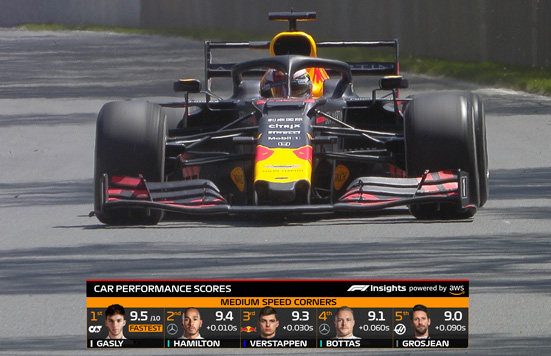AWS races ahead with machine learning on F1 stats
- June 24, 2020
- Steve Rogerson

Amazon Web Services (AWS) is introducing six real-time racing statistics that will roll out through the 2020 Formula One season, beginning with the launch of car performance scores at the season opening grand prix in Austria on July 5.
Car performance scores isolate an individual car’s performance and allow race fans to compare its performance to that of different vehicles head-to-head. The new set of statistics to be released this season will use a range of AWS services, including machine learning, to give fans the ability to compare their favourite drivers and cars and better predict race outcomes.
With 300 sensors on each F1 race car generating more than 1.1 million data points per second transmitted from the cars to the pit, Formula One is a data-driven sport where much of the thrill comes from extracting details on performance statistics. F1 relies on the breadth and depth of AWS services to stream, process and analyse that flood of data in real time, and then present it in a meaningful way for F1 global TV viewers.
The car performance scores insight will display as an on-screen graphic that provides fans with a breakdown of a car’s performance using four core metrics: low-speed cornering, high-speed cornering, straight line and car handling. The graphic will illustrate how those metrics compare from one car to another, enabling race fans to gauge a given car’s relative performance in those different areas and see where each team and driver is leading the pack or losing crucial time to their rivals.
F1 and AWS previously announced six F1 insights, including exit speed, predicted pit stop strategy, pit window, battle forecast, pit strategy battle and tyre performance and will roll out the six additional insights from July to December this season, offering fans more visibility into the split-second decision-making and action on the track, as well as behind the pit wall where the team strategists operate.
The six added insights are:
- Car performance scores: Isolates an individual car’s performance and allows race fans to compare its performance to that of different vehicles head-to-head, debuts July 5 at the Austrian Grand Prix.
- Driver speed comparison: Allows race fans to see how their favourite drivers compare with other drivers in history, dating back to 1983, to help determine the fastest driver of all time, debuts August 9 at the British Grand Prix.
- High- and low-speed corner performance: Allows fans to see how well drivers tackle the fastest bends on the track travelling at more than 175km/h and slow cornering below 125km/h compared with other vehicles, which is critical to lap time, debuts August 30 at the Belgian Grand Prix.
- Driver skills rating: Breaks down and scores driver skills, based on the most important factors for overall performance, to help identify the best total driver on the track. By calculating varying subsets of qualifying round performance, starts, race pace, tyre management, and overtaking and defending styles, this insight will provide an overall driver ranking, debuts the second half of the season.
- Car and team development and overall season performance: As the season unfolds, this will plot a team’s cumulative performance from race to race to uncover the development rates of each team, debuts the second half of the season.
- Qualifying and race pace predictions: Gather data from practice and qualifying laps to predict which team is poised for success ahead of each race session. These predictions should create heightened intrigue and excitement for the Saturday qualifying session and Sunday race, debuts the second half of the season.
“Over the past two years, Formula One has embraced AWS’s services to perform intense and dynamic data analysis,” said Rob Smedley, chief engineer of Formula One. “The F1 Insights we’re delivering together are bringing fans closer to the track than ever before, and unlocking previously untold stories and insights from behind the pit wall. We’re excited to be expanding this successful relationship to bring even more insights to life, allowing fans to go deeper into the many ways that drivers and racing teams work together to affect success.”
To create these insights, Formula One will use 70 years of historical race data stored in Amazon Simple Storage Service (Amazon S3), combined with live data that are streamed from sensors on F1 race cars and the trackside to the cloud through Amazon Kinesis, a service for real-time data collection, processing and analysis.
F1 engineers and scientists will use these data to leverage machine-learning (ML) models with Amazon SageMaker, AWS’s service for building, training and deploying ML models. F1 is able to analyse race performance metrics in real time by deploying those ML models on AWS Lambda, which runs code without the need to provision or manage servers.
All the insights will be integrated into the international broadcast feed of F1 races around the globe, including its digital platform F1.tv, helping fans to understand the split-second decisions and race strategies made by drivers or team strategists that can affect a race outcome.
“Formula One racing mixes physics and human performance, yielding powerful but complex data that AWS is helping them to harness,” said Mike Clayville, vice president at AWS. “Our existing relationship with F1 has already produced statistics that have brought fans into the race paddocks, and our study of race car aerodynamics is influencing vehicle designs for the 2022 season. This year, we’re thrilled to extend the power of F1 data in the cloud and unlock new insights that help fans understand more of F1’s rich complexity.”




